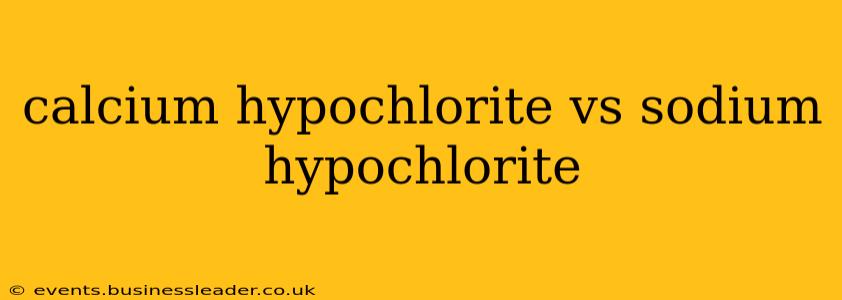Choosing between calcium hypochlorite and sodium hypochlorite for disinfection purposes can be confusing. Both are powerful bleaching agents and disinfectants, but they differ significantly in their chemical composition, effectiveness, and applications. This comprehensive guide will delve into the key differences, helping you make an informed decision based on your specific needs.
What is Calcium Hypochlorite?
Calcium hypochlorite, commonly known as bleaching powder or chlorinated lime, is a chemical compound with the formula Ca(ClO)₂. It's a white powder, often granular, with a strong chlorine odor. This compound contains a higher percentage of available chlorine (typically 65-70%) compared to sodium hypochlorite, making it a more concentrated source of chlorine for disinfection.
What is Sodium Hypochlorite?
Sodium hypochlorite, also known as liquid bleach, is a chemical compound with the formula NaClO. It's typically a pale greenish-yellow liquid solution. The concentration of available chlorine in sodium hypochlorite solutions varies widely, ranging from 3% to 15% in common household bleaches. Industrial-strength solutions may have higher concentrations.
Calcium Hypochlorite vs. Sodium Hypochlorite: Key Differences
| Feature | Calcium Hypochlorite | Sodium Hypochlorite |
|---|---|---|
| Chemical Form | Solid powder/granules | Liquid solution |
| Available Chlorine | Higher (65-70%) | Lower (3-15%, varies significantly) |
| Solubility | Less soluble in water | Highly soluble in water |
| Stability | Less stable, degrades faster than sodium hypochlorite | More stable, especially in diluted solutions |
| Handling | Requires careful handling due to dust inhalation risk | Easier to handle and measure |
| Cost | Often less expensive per unit of available chlorine | Can be more expensive per unit of available chlorine |
| Applications | Swimming pool sanitation, water treatment, bleaching | Household cleaning, laundry bleaching, water treatment |
Which is Better for Swimming Pools?
Both are used for swimming pool sanitation, but calcium hypochlorite is often favored for its higher available chlorine concentration, making it more economical for larger pools. However, handling calcium hypochlorite requires more care due to its dust and potential for generating chlorine gas when mixed incorrectly. Sodium hypochlorite's ease of use and lower risk make it a popular choice for smaller pools and those with automated sanitation systems.
How long does calcium hypochlorite last?
Calcium hypochlorite's shelf life depends on storage conditions. Proper storage in a cool, dry place away from moisture and heat is crucial to maximize its effectiveness. It generally loses its potency over time, becoming less effective at disinfection. Check the product label for the manufacturer's recommended shelf life.
How long does sodium hypochlorite last?
Similar to calcium hypochlorite, sodium hypochlorite's shelf life is influenced by storage. Keeping it in a tightly sealed, opaque container away from direct sunlight and heat will prolong its effectiveness. Diluted solutions lose potency more quickly than concentrated ones.
Which is Better for Water Treatment?
The choice for water treatment depends on several factors, including the scale of the treatment, the required chlorine concentration, and the desired method of application. Calcium hypochlorite is frequently used in large-scale water treatment facilities due to its high available chlorine content and cost-effectiveness. However, sodium hypochlorite is also widely used, particularly in smaller systems or for on-site treatment.
Which is Better for Household Use?
For household cleaning and bleaching, sodium hypochlorite (liquid bleach) is almost universally preferred due to its ease of use, solubility, and lower safety risks associated with handling. Calcium hypochlorite's powder form makes accurate measuring more difficult and poses a greater inhalation risk.
Safety Precautions for Both Compounds
Both calcium hypochlorite and sodium hypochlorite are strong oxidizing agents and should be handled with care. Always wear appropriate personal protective equipment (PPE), including gloves, eye protection, and a respirator when handling them. Follow the manufacturer's safety instructions carefully. Avoid mixing them with acids or other chemicals, as this can produce dangerous gases. Store them securely, away from children and pets.
In conclusion, the best choice between calcium hypochlorite and sodium hypochlorite depends entirely on the intended application and the specific needs of the user. Considering factors like cost, availability, ease of handling, and required chlorine concentration is crucial for making the right decision. Remember to always prioritize safety and follow all relevant safety guidelines.
